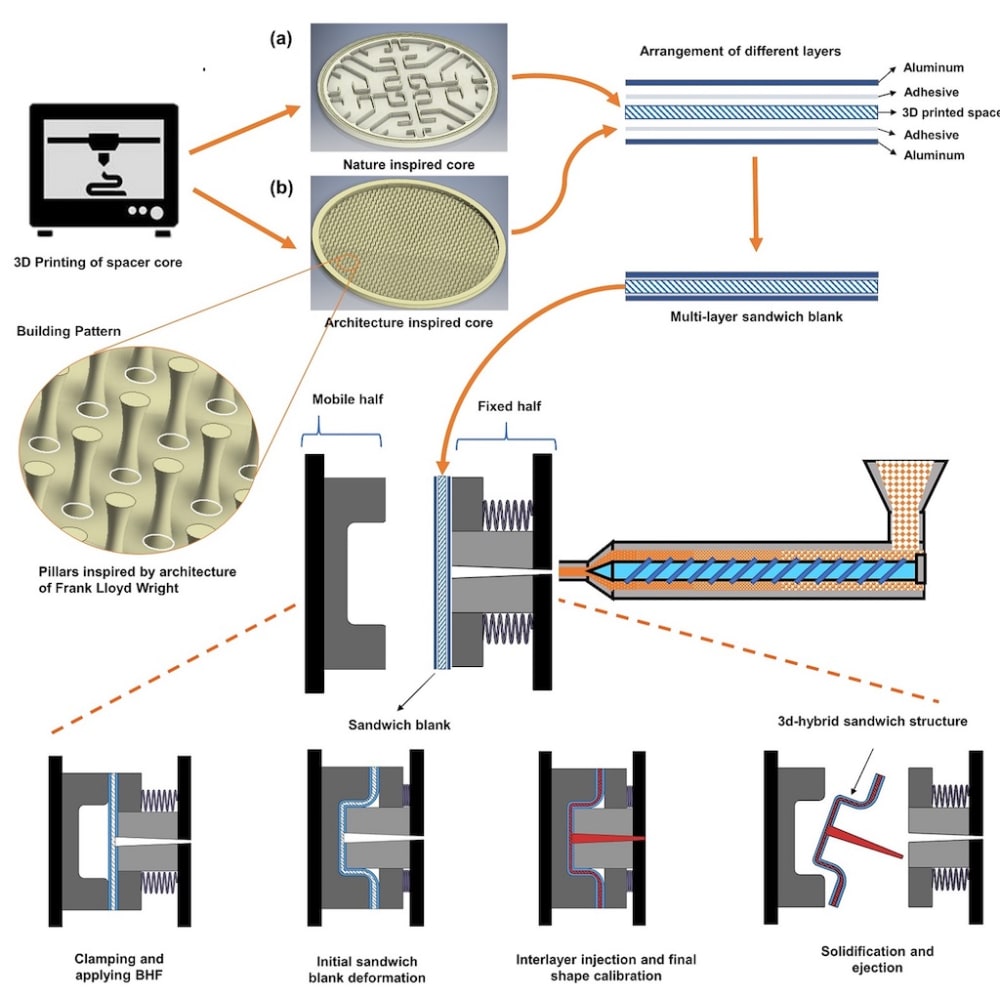
Background and Motivation
The conceptual manufacturing process of Hybrid Single Shot (HSS) has been developed by Clemson Composite Center to enable production of customized hybrid structures in one single operation. The metal-polymer sandwich structures provide superior properties such as high bending inertia, sound and heat insulation, and high energy absorption, which make them attractive for aerospace and recently automotive applications. Conventionally, 3D sandwich structures are produced either through a multi-stage manufacturing process or by forming a prelaminated blank. The former approach is not efficient enough for mass productions and the later one limited the forming geometry due to excessive shear tension and interlayer delamination. Hence, in this work, a new process is introduced in which a 3D sandwich structure can be produced by combining additive manufacturing, deep drawing, and injection molding.
The Technology
In the conceptual manufacturing technology, first, the spacer core is 3D printed, taking inspiration from nature and architecture for custom core design. The channels in Figure 1(a) help to maximize the flow of the polymer melt while the spread of biconical pillars in Figure 1(b) provide structural support. The core is then placed in between metallic facings, with a layer of thermally activated adhesive in between. The stacked sandwich blank is then placed in between two halves of the mold. The specialized tool designed and fabricated for this process is innovative in the independent application of the blank holder force (BHF) from the preset clamping force on the injection molding machine. When the mobile half of the mold is closing, first, the sandwich blank is clamped between the cavity plate and the blank holder plate then deformed into the cavity by the force of the punch. After the initial deformation, the polymer melt is injected into the free space provided by the 3D printed spacer to form the interlayer and calibrate the geometry of the final 3D sandwich structure.
Benefits
• 3D printing the spacer core provides opportunities to have more customized properties and specialized functionalities. For example, embedded 3D printing of strain sensors within highly stretchable elastomers can be used for part health monitoring.
• Stacking the layers of the sandwich blank before deformation provides the maximum design flexibility in terms of selecting sheet materials, bonding agents and thickness configuration.
• Injecting the interlayer after the deformation of the sandwich blank eliminates issues such as delamination, indentation, and wrinkling.
• Using the heat and pressure of the injection process can effectively promote the bonding process and save the total time and energy consumption of the production.
Applications
The concept manufacturing process can be used to produce:
• Automotive structural components such as A and B pillars, panels and load bearings beams
• Battery cases for electric vehicles
• Aerospace components such as leading-edge wings, pressure bulkheads, and blast-resistant cargo containers
• Pressure vessels and storage tanks
• Composite doors and windows
This process can also be employed as an alternative repair procedure for composite structures due to the high flexibility of the process configuration.
-
Awards
-
 2019 Top 100 Entries
2019 Top 100 Entries
Like this entry?
-
About the Entrant
- Name:Saeed Farahani
- Type of entry:teamTeam members:Saeed Farahani a,b, Aman Vaibhav c and Srikanth Pilla a,b,d,e
a Department of Automotive Engineering, Clemson University, Greenville, SC, 29607, USA
b Clemson Composites Center, Clemson University, Greenville, SC, 29607, USA
c Department of Mechanical Engineering, Indian Institute of Technology Madras, Chennai, Tamil Nadu 600036, India
d Department of Mechanical Engineering, Clemson University, Clemson, SC, 29634, USA
e Department of Materials Science & Engineering, Clemson University, Clemson, SC, 29634, USA - Patent status:none

